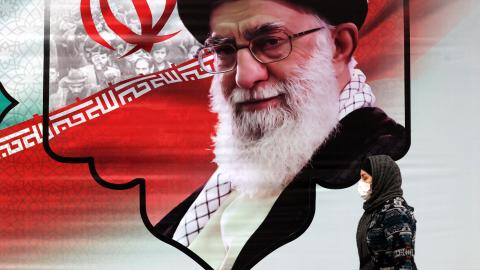The brutal killing of Mahsa Amini by Iran’s notorious morality police in September 2022 sparked protests all over the country. The scope and scale of these demonstrations prompted some pundits to call it a women-led revolution. A CNN contributor concluded that the clerical regime may be at a point of no return, and the current protests transcend Iran’s many social and ethnic divisions.
Nevertheless, to many Iran watchers’ surprise, the protest movement is now waning. The regime is far from being at the "point of no return" because pro-status quo forces, even within the protest movement itself, are resisting change. Despite early hopes, this movement has failed to transcend gender, ethnic, and sectarian divisions in Iran, and this is why it is failing.
To understand why, one must know that Iran has an apartheidlike systemic discrimination structure under which men, Shiites, and Persians are part of a privileged class. Women, non-Shiites, and non-Persians are marginalized and discriminated against. As a Kurdish Sunni woman, Amini was a manifestation of all three underclass groups. And to be clear, this is not like Western countries where minorities might be slighted or informally excluded — to the contrary, these groups are explicitly, systematically excluded as a matter of written law, in some cases within Iran's very constitution.
For example, under Iran’s civil laws, women and girls are treated as second-class citizens, worth “half in value” in life, in court, in the workplace, and in death. The current protests started as a feminist movement, calling, among other things, to end compulsory hijab-wearing and other discriminatory laws against women. But forces opposed to the regime yet in favor of the status quo fought back, injecting a patriarchalism that has superseded the original feminine nature of the uprising. Both regime officials and major opposition figures have come to respond to the slogan, "Woman, Life, Freedom," with the retort, “Man, Homeland, Prosperity.” Pro-monarchy Persian nationalists have embraced this mantra, steering the revolution away from any hint of feminism or even women’s rights.
Undoubtedly, without women’s participation, Iran’s pro-democracy movement is less likely to succeed. The Iranian society and mainstream opposition organizations need to abandon their chauvinistic tendencies and embrace maximum liberation and utmost participation of women.
Initially, as with women, non-Persian ethnic groups were leading the protest movement in Iran, including Azerbaijani Turks, Kurds, Arabs, and the Baluch. But even as non-Persian ethnic minorities bore the brunt of the regime's violent crackdown, the Iranian regime and old-guard opposition forces have informally worked together to keep a reactionary and chauvinist pro-Persian status quo intact. Ethnic discrimination, among other things, is hindering the protest movement from within, as Persian chauvinism promises to unite all Iranians by assimilating Iran’s multiethnic population under the mantra of “One Language, One Nation, One Leader, One Motherland.” The goal of denying the cultural rights and even the very existence of other ethnic groups in the country is one that the regime shares with many of its opponents, and this is fracturing the opposition.
Both the regime and the Persian nationalist opposition use the term “territorial integrity” to demonize and justify the suppression of ethnic and religious minorities in Iran. The slanderous term is used as a coded word that implies that non-Shiites and non-Persian ethnic groups are less loyal to Iran and thus deserve to be treated with suspicion, as less Iranian, and second-class citizens. If the revolution is to succeed, Persian-dominated opposition organizations need to revisit their long-held exclusionary tendencies and include ethnic political institutions and other marginalized groups in Iranians’ collective struggle for democracy.
With respect to religion, Iran’s constitution dictates that only Shiite Muslims can hold senior political, religious, and administrative positions. The Sunni protesters — including Kurds and the Baluch — have borne the brunt of the violence suppressing the current protests in Iran. In just one protest, nearly 100 Sunni Baluch protesters were killed by the Iranian regime forces. A large number of Sunni Baluch don’t even have national identification cards or citizenship documents — they are not considered proper Iranian because of their ethnic and religious affiliation.
Persian monarchists oppose any leader who belongs to non-Persian and non-Shiite groups, again citing the risk of Iran’s disintegration and the collapse of its "territorial integrity." This is the very same tactic that the regime uses to mobilize its base by blaming non-Persian protesters for separatism and secessionism. Persian nationalist groups have taken an especially divisive role by campaigning to restore power to Iran’s exiled prince to lead the transition from clerical to secular rule. This demand represents a major blow to the protest movement, pitting Iranians against each other. Persian nationalists in the diaspora claim Prince Reza Pahlavi is their representative, whereas Azerbaijanis and other non-Persian ethnic groups have strongly rejected the idea of restoring the monarchy in post-Islamic Republic Iran.
The Mahsa Amini protest movement, in its early phases, was representative of all underrepresented communities in Iran. Amini was a Sunni Kurdish woman, and her killing forced a face-off not only between the regime and its opponents, but also between the traditionalism of the privileged ruling class and a more modernist opposition more inclusive of women, non-Persians, and non-Shiites. The current fractured opposition movement keeps failing because it is not challenging the status quo of Persian chauvinism, political patriarchy, and Shiite fundamentalism.
To succeed, a movement needs to promise credibly a just, inclusive, free, and equitable future. It is unlikely that a protest movement divided along ethnic, sectarian, and gender lines can succeed in overthrowing a regime entrenched for more than four decades now. Until the privileged class revises its supremacist ideology and embraces this egalitarian and feminine movement in Iran, pro-democracy Iranians will not overcome the inertia of the status quo.















